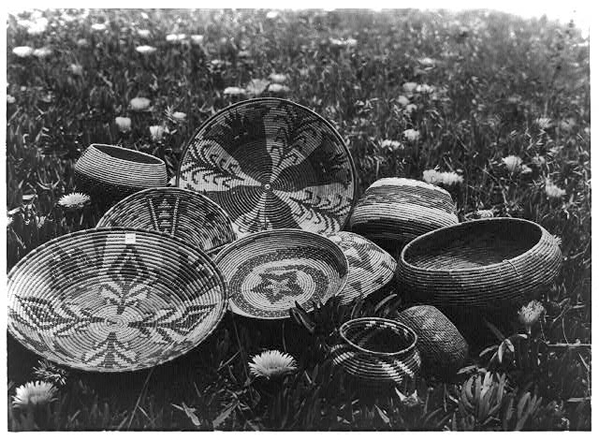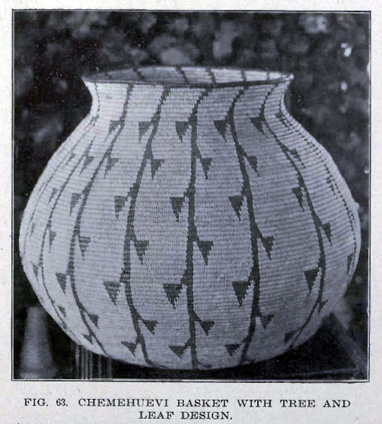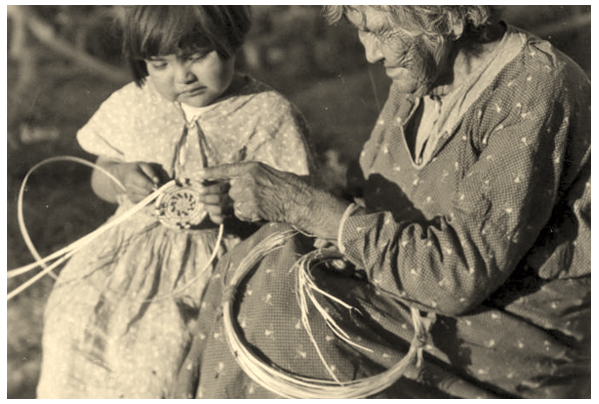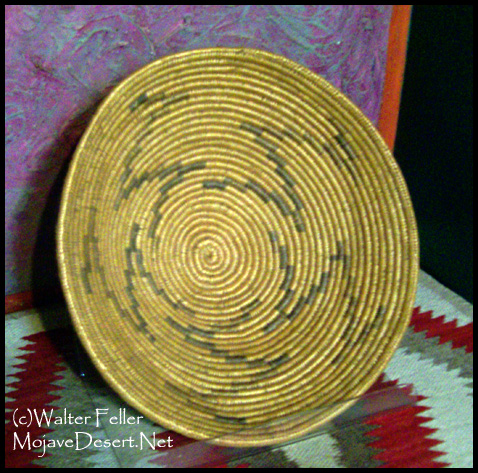Indian Basketry
California Indian basketry is one of the great
textile traditions of the world, extending
some 5,000 years into the past.
Encompassing remarkably diverse
biological environments, nearly
every Native community within the
state excelled at basketry, creating a
marvelous palette of distinctive, regional
weaving traditions – from the rainy redwood
forests of the North Coast to the arid expanse of Death Valley.

Admired for their aesthetic merits, the role and development of basketry was born of necessity, rooted in
a way of life that relied on baskets to collect, transport, process and store diverse food resources. Strong,
durable, lightweight, and often watertight, Native baskets were perfected to suit local food collecting
economies. They were cooked in and eaten out of. Winnowing seeds, sifting acorn flour, storing water,
serving guests, cradling infants – all were done with baskets.
What makes a Masterpiece?

Though beauty may be in the eyes of the beholder, and though many baskets exhibit wonderful qualities, there are certain factors that contribute to exceptional pieces of basket art.
Technique
A weaver’s technique – her mastery of the various weaving techniques practiced by her people. This entails her use of even tension while weaving, and control of the foundation, which results in a gradual and elegant shaping of the basket, as well as a smooth surface.Materials
A basket is only as fine and beautiful as the material that goes into it. The great weavers were extremely diligent in the selection and preparation (splitting, trimming, sizing) of their weaving materials. This also meant persistent tending of the plants and their environments, which fosters growth of fine quality material.Execution of Design
 The conceptualization and execution
of designs, whether restrained and conservative, or complicated
over-all patterns, great weavers have the ability to evenly space
and render their designs with great crispness and clarity. One
might say their designs appear “painterly” – so well defined,
they look as though they were painted on afterwards.
The conceptualization and execution
of designs, whether restrained and conservative, or complicated
over-all patterns, great weavers have the ability to evenly space
and render their designs with great crispness and clarity. One
might say their designs appear “painterly” – so well defined,
they look as though they were painted on afterwards.
Baskets were inseparable from daily life. Homes were well stocked with baskets of more than a dozen different types – they hung from ceilings, were stacked inside one another, and lined the walls. In addition to their essential role in the food economy, baskets fulfilled a broad spectrum of roles in Native societies. The origin of basketry is often found in tribal mythology – as the basket prefigures the arrival of human beings.
Baskets represented valuable property, often beautified beyond any functional need, serving as important symbols of reciprocal relationships among families and communities. They were also expressions of family wealth and status. In sponsoring a ceremonial gathering, a village headman and his family served plentiful amounts of acorn soup in especially fine and decorative serving baskets – at times so large it took four men to carry – in a grand display of prosperity.
Baskets have always been instrumental in ceremonial contexts: holding water for the ritual washing of mourners at a funeral; as a container for medicine used in healing ceremonies; inverted and tapped as a drum to accompany singers praying for a good acorn crop. A fine basket might cover the face of the deceased for burial. At memorial observances, baskets were displayed on long poles and ritually destroyed as chief indicators of valued property, and thus respect for the family of the dead.

A woman spent much of her time involved in the various stages of basket making. As baskets needed to be replaced on a regular basis, weaving was not a hobby, but a necessary activity the family depended on. Socially, the skill of a weaver was a measure of her success – as a valued provider to her family and community, and an artist with abilities worthy of admiration.
Seed Gathering
Though acorns have been widely recognized as a staple of Native cultures throughout much of California, the development of the tightly woven burden basket is linked to seed gathering. The use of seeds – about three dozen varieties – as an important food resource extends back several thousand years, and probably pre-dates acorn usage. Seeds were collected from shrubs, flowering plants, and native grasses that were once abundant. The conical shape of the basket, with its wide mouth, facilitated the gathering of seeds as they were whisked into the basket by a seed beater held in the other hand. Seeds were placed in a shallow tray, rubbed to loosen the husks, then winnowed by gently tossing them into the air to separate seeds from chaff. The seeds were then parched by adding a few hot coals, and moving them about in the winnowing tray. This process amazed French explorer Jean Francois de La Perouse near Monterey in 1776, who observed: “They turn these vessels with such dexterity and rapidity that they succeed in causing grain to swell and burst without burning the basket, though made of combustible material.” Once parched, the seeds were ground into fine flour and prepared as a thin soup. Seeds could also be added to acorn bread (i.e. seeded bread). Seeds with high oil content were pounded into a paste, rolled into small balls, and eaten dry. Because of its continually expanding shape, a thousand sticks might be necessary for the foundation of a close-twined burden basket.Virtuosity
By the late 19th century, California Indian basketry had become one of the most sought after art forms in America. Weavers responded with innovations, often modifying traditional forms, and refining techniques to superfine levels – exploring the limits of their abilities and imaginations. Between approximately 1890 and 1930, an era of unprecedented production and artistic innovation characterized Native weaving.
The “art basket” was made primarily for export, as an object of art, destined for the parlor shelves of wealthy Americans. For “professional” weavers, the art basket became part of a new economic strategy. Some weavers received national reputations, such as Washoe weaver Louisa Keyser [Dat-so-la-lee].
Mary Benson, Lena Dick, and Mabel McKay were exemplary basket weaving artists of the 20th century. Their works became distinctive, masterful examples of a traditional art form. Through their refined and uncompromising technique, personal artistic vision, and imagination, they created new baskets – anchored in tribal tradition – but carried to another level. Their virtuosity was a testament to their great skill as weavers, but also their desire to excel.
Into The 21st Century
Following a steady decline over the course of the past century and a half, the fate of Native basketry began to turn around in the late 1950’s. Oneearly effort to resuscitate basket making was led by Vivien Hailstone (Yurok/Karuk). Hailstone organized workshops pairing master weavers with students. She advocated widely the Native basketry was indeed worth saving.By 1992, the California Indian Basketweavers Association had formed to “preserve, promote, and perpetuate California Indian basket weaving.” Through annual gatherings and workshops, CIBA has linked elder weavers with a new generation eager to learn the art. CIBA has challenged federal and state agencies that control public lands, regarding weaver’s rights of access to materials, and the use of pesticides by forest service agencies, citing the inherent health risks to weavers.
In Native communities – where the link to a cultural heritage has often been damaged – relearning this masterful textile tradition has found great relevance. Here, in the early stages of the 21st century, this ancient art continues to resonate among a new generation of Native weavers as a source of great pride and a meaningful, inspirational connection to culture, family, and land.
source: California State Parks